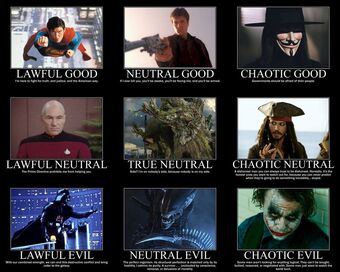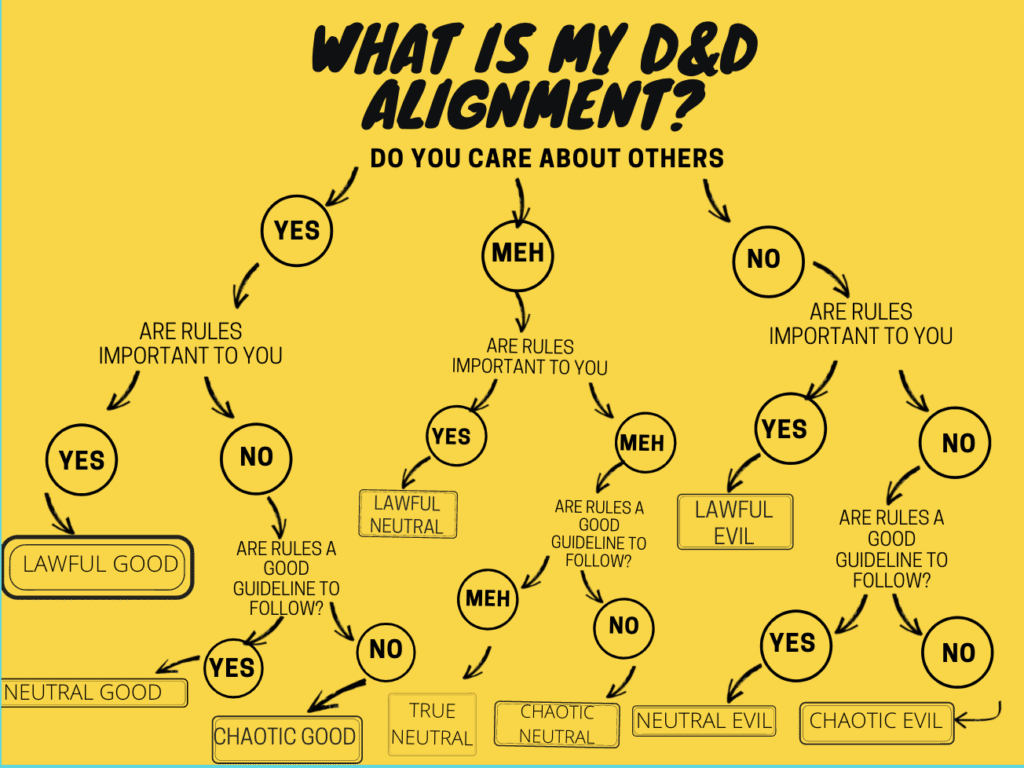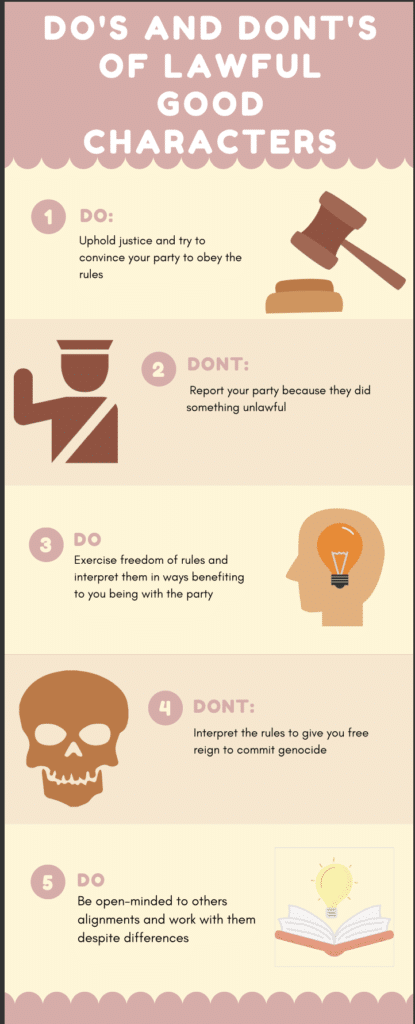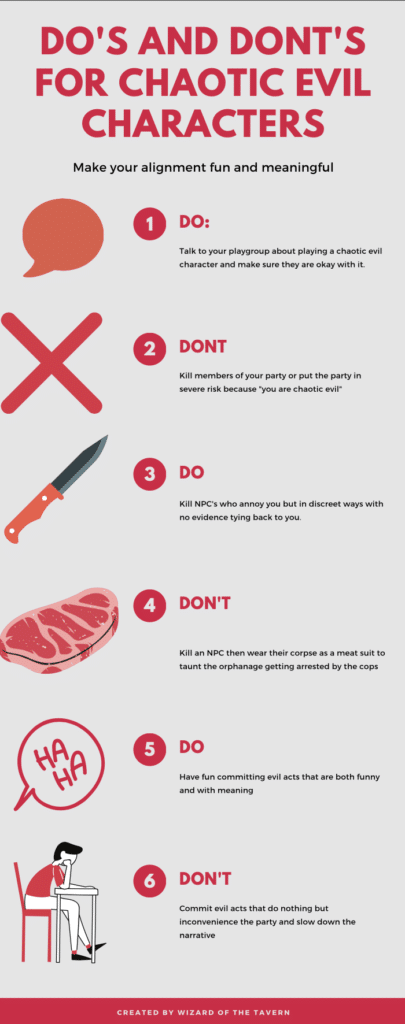D&D Alignments… What defines chaotic from lawful and good from evil? There are a million and one graphs out there attempting to define and explain D&D alignment. For those unaware, D&D alignment works as an attempt to define a player’s character to justify their decisions and personality traits.
For instance, a lawful good Paladin is opposed to evil actions and as such obeys the laws deemed good. Meanwhile, a chaotic evil wizard will do things randomly for the sake of evil. The issue is, so many parties and campaigns have been ruined by one person’s decision to play a certain alignment. As such this guide is to help players navigate the realm of morality in D&D.
What Are The 9 D&D Alignments?
The 9 alignment’s people use to define themselves are: Lawful Good, Neutral Good, Chaotic Good, Lawful Neutral, True Neutral, Chaotic Neutral, Lawful Evil, Neutral Evil, and Chaotic Evil. This creates morality charts like the one below.

These D&D alignments are created through two categories: Morality and Obedience.
Morality has three subcategories most commonly called: Good, Neutral, and Evil. Good aligned characters are those dedicated to doing good actions in the world through just means. Neutral are those dedicated to doing whatever is in their best interest. While evil is those dedicated to performing any actions they want to achieve their objective. These are important clarifications as understanding how these interact with your character is essential to choosing your appropriate alignment.
Meanwhile, Obedience has three subcategories to help distinguish their ability to conform to a scenario. These subcategories are: Lawful, Neutral, and Chaotic. Their importance is to establish what kinds of means your character will perform to accomplish their Good, Neutral, or Evil task. A lawful character will attempt to do good through the legal structure they were raised on. A neutral character will obey the laws until they need to do something else for their survival. Meanwhile, a chaotic character will more often than not perform actions that do not necessarily obey what the majority would call “status quo”.
It is important to note, while Morality is the most talked-about category for a character. The Obedience category is where most mess up on their character alignment.
Difference Between Lawful And Chaotic
To understand where someone lies on the Obedience spectrum, we need to define the ends. Obedience is on a spectrum from Lawful to Chaotic. This means we need to figure out what lawful and chaotic means.
For defining them we need to take a look at two common philosophies: “End”(1) The end justifies the means, or “Means”(2) the means justify the end. In both of these thought processes, they attempt to determine how important the process is to achieve a goal. As such see Obedience is how a character will perform an action and morality is why the character will perform said action.
I should also note, not a single philosopher has come across a universal answer to this debate. This includes me, what I am attempting to do is merely establish parameters into an easy way to decide which D&D alignment best fits your character. With that said let’s get back to the subject.
To define Lawful we need to take a look at the thought process of means Characters on the lawful side are more focused on the means more than the end. As such, they will follow the rules defined by the area they are in. Seeing rules as mandatory unless absolutely necessary.
Neutral on the other hand is hardest to define as they care about both equally. They are willing to disobey the rules to achieve their goal but will usually follow them. Seeing rules and laws as a guideline for how to do things but not a necessity.
Meanwhile, a chaotic character is focused on the end rather than the means. This has them willing to do stuff not defined by the area they are in and challenge the status quo and rules to achieve their objective. In this sense, they see rules as more of a suggestion than rules.
Defining Good, Neutral, and Evil
What is Good? What is Evil? The questions asked by anyone trying to sound philosophical. Now that we have established the means by which characters perform actions, we need to talk about the end. The end is quite simply what is a character’s goal when performing an action. To make simple:
A Good character will focus on things often associated as inherently just by those of the same alignment.
A Neutral character will focus on things that better the community they care about as their opinion is what defines the action they will take.
Meanwhile an Evil character will focus on things that only better himself and his end goals.
Therefore, whenever your character performs an action ask yourself it is in your alignment. If you are good, “Are you doing something that another person of the same alignment would most likely agree on?” Meanwhile, if you are neutral performing an action, you should ask yourself, “does my character have something he cares about that is for the sake of or justifies this decision (i.e. saving their life or making their life better)?” While evil characters should ask “does this further my goals (while not going against the party)?” If the answer is yes to these questions then you are most likely doing a correct decision based on your D&D alignment.
D&D ALIGNMENT TEST
Now that D&D alignment is explained and the pitfall to alignment is addressed. I will attempt to explain the alignment labels in an easy way for those using the system.

- LAWFUL GOOD: A character who follows the rules and status quo of the culture raised in attempting to do actions that are approved by people seeking the betterment of the world.
- Do’s: Help try to steer your party into doing what is right and legal.
- Don’t: Report the party rogue for stealing.
- NEUTRAL GOOD: Does their best to obey rules but will disobey them if they know the action is for the betterment of the world.
- Do’s: Obey laws and customs unless the party or situation says otherwise.
- Don”t: Kill someone because they made fun of you.
- CHAOTIC GOOD: Is not afraid to go against the rules established by an organization if it means the betterment of the world and those of like alignment would most likely agree.
- Do’s: Be willing to try and convince the lawful to get their hands dirty but don’t go against the party for the sake of “being good”.
- Don’t: Commit genocide for the greater good
- LAWFUL NEUTRAL: Generally follows the rules because see’s no reason why they negatively impact them.
- Do’s: Obey the laws not because they do good but because they don’t affect you negatively.
- Don’t: Be a stickler for the rules if the party is wanting to bribe a player.
- TRUE NEUTRAL Follow the morality of the people they are around. If they are chaotic evil so is he and if they are lawful good he is as well.
- Do’s: Be the amplifier for the party, what the party’s morality is is your morality and you define it.
- Don’t: Have no opinion and no input on anything… aka boring.
- CHAOTIC NEUTRAL: Not opposed to doing petty crimes or going against the standard for their amusement.
- Do’s: Do small illegal stuff for fun and suits you.
- Don’t: Don’t kill, rape, or pillage for fun because you don’t care.
- LAWFUL EVIL: Are squeaky clean rule-followers on the surface but will manipulate, extort, and blackmail to get the rules of the world to be in his favor.
- Do’s: You obey the laws and make the laws work toward your whims.
- Don’t: Become a politician when the party wants to do adventures.
- NEUTRAL EVIL: Will follow the rules for the most part but if push comes to shove isn’t afraid to make the world realize your business.
- Do’s: Commit evil to further your well-being such as playing casting fireball into a rival’s house.
- Don’t: Cast fireball on your party while sleeping.
- CHAOTIC EVIL: They will do things seemingly at random but really cause they want to watch the world burn and know this will irritate the world.
- Do’s: Sign deals with devils, break said deals, then commit more sins for ultimate power.
- Don’t: Kill a player because he blinked weird.
While these may not be a perfect description for your character and alignment they stand as a good anchor point for each D&D alignment to figure out what actions are deemed in alignment.

Pitfalls Of D&D Alignment
Now that you have an idea of how D&D alignment is set up, let’s talk about two common pitfalls of alignment. If you have ever played with a chaotic evil or a lawful good character, you have probably hated D&D before. It is almost a running joke that evil characters will kill the party and lawful good characters will get the party killed. This leads to the pitfall of alignment, people use alignment to justify being rude.
There is one true rule in D&D don’t go against the party. It is a rule many people either don’t know or ignore, but it is crucial. Many players forget this rule when it comes to alignment as they use their backstory or real-life thought process to define their character’s morality. The truth is morality in D&D is different from morality in real life.
This might sound confusing but makes sense when you think about how the characters are not real, but the players are. When someone goes against the party it no longer becomes a D&D issue but a real-life issue. If another player kills your character and says, “I am chaotic evil so it is justified”. You are not explaining that to the character… after all, you just killed them. But, what you are doing is explaining that to the player. Which, immediately means you are using an in-game alignment to make a real-life decision. That’s like saying I steal from people in video games so I am justified for stealing in real life. It won’t hold up in court.
Pitfalls Solutions
There are two easy solutions to either prevent the pitfall, or deal with it once it occurs.
The first one that prevents 99% of pitfalls is to ignore the alignment ruling. This prevents players from attempting to justify their characters’ decisions with alignment and instead go off of how the narrative plays.
What happens if a character finds themselves in a situation directly against their characters defined morality or personality. For example, what if the party wants to slaughter 50 infants and spread their feces over themselves proclaiming themselves gods? What to do then if your lawful good character doesn’t like this?
The answer is simple, walk away, don’t kill the party, don’t get them in trouble, don’t do anything that will negatively impact the narrative. Simply attempt to reason with them that they should not, if they say no and this is where your character draws a hard line, your character walks away from the game. Then you create a new one that would be willing to do that and you shelve your righteous character for a future campaign. This way the narrative is not ruined but added on. The other characters must come to terms with that character’s decision and adjust to a new party dynamic.
Now if you, the player, are not comfortable with the decision, then you state to the other players you are not comfortable and attempt to work it out as players and not characters. If they still do it and that is where you draw a hard line, then politely leave and say this is not the kind of game I want to play. This prevents the most disruption and allows everyone to move on.
In this way, the players no longer have personal stakes that cause the issue and can address the issue in a civil way with the immediate issue resolved.

D&D Alignments Summary
Now you should have a good general understanding of D&D alignments and how they are implemented in a campaign as well as common pitfalls. This lets your understanding of how obedience v morality impacts each other to successfully understand choices your character should make. Moreover, you now know some common pitfalls to expect with certain alignments and the best ways to handle them.
